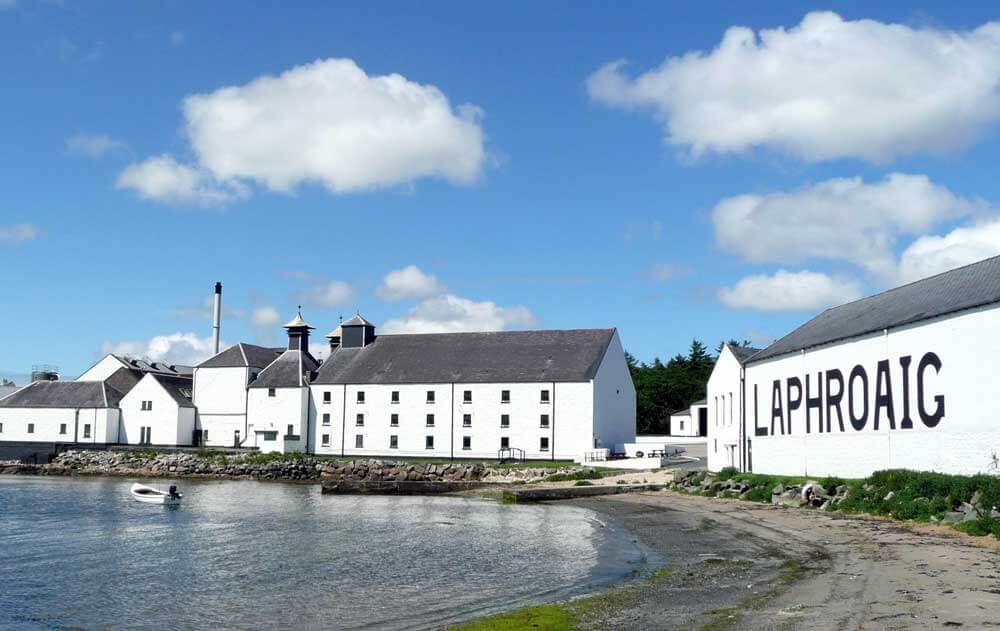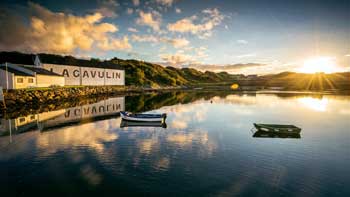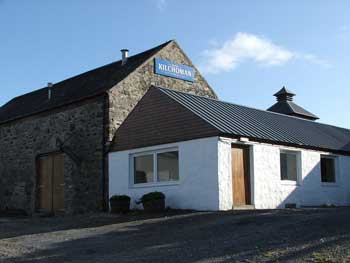
The Islay Scotch Whisky Region is one of the five regions recognised by the Scotch Whisky Association.
This page says a little about the beautiful Islay Scotch whisky Region and has information about some of its best-known distilleries with links to their distillery tours.
where is the Islay Scotch Whisky Region?
Islay in Scotland’s Inner Hebrides, home to a number of whisky distilleries, is an island with whisky in its blood and history at its heart. Pictish warriors, Vikings and followers of Somerled have all passed this way.
Archaeological discoveries have allowed a much better understanding of this place.
Among the earliest finds is the 8th century Kildalton Cross on the south-east of the island, a reminder that Islay was part of the Gaelic kingdom of Dál Riata.
Finlaggan, Islay
Finlaggan, sometimes described as the “cradle of Clan Donald,” a few miles from Port Askaig was once the centre of the Lordship of the Isles.
Its visitor centre tells the remarkable story of a momentous period in Scotland’s history. Unsurprisingly it’s a popular place to visit.
Today the hills, rivers and beaches of Islay are more likely to be populated by bellowing red deer, elusive otters, inquisitive grey seals and, depending on the season, a multitude of feeding and breeding birds.
The annual Islay Festival of Malt and Music, with traditional music, ceilidhs, poetry, piping and distillery visits is a great opportunity to soak up some of the local culture and make new friends.
Visit Scotland has lots of information about what to see and do and where to stay on Islay along with all the details of the whisky distillery’s tours and tastings. Visit their official website to learn more.
Islay whisky distilleries you might like to visit
Laphroaig Distillery
The Laphroaig Distillery is situated in the south of Islay around 12 miles from the island’s main town Bowmore.
In the company’s words “Our home is a breathtaking and rugged island cast adrift off the West coast of Scotland.”
In 1815, brothers Donald and Alexander Johnstone founded Laphroaig, ‘broad hollow by the bay’ after deciding that whisky making was more lucrative than farming. Sadly, Donald died in terrible circumstances in 1847 when he fell into a vat of pot ale. Ownership of the distillery remained in the family for 139 years.
It was Donald’s great-grandson Ian Hunter who took the business to the next level by increasing capacity and finding new markets in the United States, learning in the process that bourbon casks could greatly influence his whisky.
In the following years, the business changed hands a number of times. Beam Suntory, who took control in 2014, is the current owner.
Water, soft, peated and non-mineralised comes from the distillery’s own reservoir by way of the Kilbride Stream. Peat is hand-cut, with floor malted barley (some from other sources) and capacity is around 3m LPA.
Among the core range are Select, without age statement. Triple Wood, 10 Year Old, and Port Wood, a single malt double aged and finished in ex-ruby port casks.
In 2019, the company released the first edition of a new series, the Ian Hunter Story, a non-chill filtered whisky with the characteristic peatiness expected from Laphroaig.
It’s a fitting tribute to the legacy of a man who did so much for his beloved Laphroaig.
There is a range of tours and tastings to choose from, with an excellent visitor centre, tasting bar and shop.
Find out more about the Laphroaig Distillery from their official website.
Lagavulin Distillery
Lagavulin Distillery, owned by Diageo, stands within sight of the ruins of Dunyvaig Castle on the south coast of Islay, only 2 miles from the small town of Port Ellen.
In 1816, Lagavulin, in Gaelic “the hollow where the mill is” was, after many years of illegal distilling on the island, the first legal distillery to open.

After a series of changes over the following years, James Logan Mackie became part owner in 1861. Later his nephew Peter, ‘Restless Pete’ took the helm and it was under his control that the business flourished.
Mackie had once been an agent for neighbouring distillery Laphroaig but left after a dispute.
Such was the acrimony between them that he built a second distillery, Malt Mills, within Lagavulin, in 1908. He designed the new facility to replicate the output of Laphroaig and damage their trade.
Although the plan failed, Malt Mills remained open until 1962 when, after extensive renovations, it became the new visitor centre.
Much of the whisky making process at Lagavulin is done slowly and with tradition in mind.
Neither distillation nor maturation is rushed. The water source is the nearby Solum Lochs and the peated malt comes from Port Ellen.
The Lagavulin range of whiskies, described by the company as, “small but mighty” includes the 16 Year Old, chosen in 1998, as one of the Six Classic Malts of Scotland. In addition, a number of special and anniversary editions are regularly released.
Today a number of tours and tastings take place on a regular basis and the distillery is an enthusiastic partner in the annual festival of Music and Malt.
Find out more about the Lagavulin Distillery from their official website.
Bunnahabhain Distillery
In 1879, William Robertson of Robertson and Baxter Blending House and the Greenlees brothers joined forces to establish the Islay Distillery Company.
By early 1883, Bunnahabhain which stands on a site close to the River Margadale on the remote north east coast of the Isle of Islay began production.
Its isolation meant that houses and other facilities had to be specially built for the workers and their families.
Today the business is owned by Diageo.
The water source is the Margadale River which is piped directly to the distillery to keep the peat content down. Two varieties of barley are used and maturation takes place on site in bourbon, sherry and red wine casks.
Bunnahabhain’s core range includes Stiùireadair Single Malt and Bunnahabhain 12, 18, 25 and 40 year olds. In addition, a number of distillery exclusives and special editions are available.
Visitors are made welcome at Bunnahabhain where there are a number of tours, tastings and a warehouse experience where you can taste a dram, unpeated and peated, straight from the cask.
In addition, their North Islay Whisky Tour is run in conjunction with some of the neighbouring distilleries.
Other tastings are held in the visitor centre which has the most magnificent view over the Sound of Islay.
Find out more about the Bunnahabhain Distillery official website.
Kilchoman Distillery
Kilchoman Distillery is located on the western side of Islay, close to Loch Gorm and is the island’s only farm distillery. Founded in 2005 by Anthony Wills, it was the first new distillery on the island for 124 years.
In February 2020, the business celebrated the opening of a new visitor centre, with a shop, tasting rooms and bar. There is also a café on site.

The distillery water source is the soft peaty water from Allt Gleann Osamail Burn.The floor maltings are on site using locally grown barley.
The maturing process takes place in bourbon barrels and sherry butts as well as several speciality casks including red wine and cognac.
Storage is in dunnage style warehousing.
The core range, non chill-filtered with natural colour includes Machir Bay, Kilchoman’s signature single malt and Sanaig a no-age-statement single malt released in 2016.
In February 2020, the business celebrated the opening of a new visitor centre, with shop, tasting rooms, bar and a café.
As one of the few independent distilleries, the owners Kilchoman Distillery Co. offer visitors the, “full whisky experience” when they take one of the tours or tastings
The core range, non chill-filtered with natural colour includes Machir Bay, Kilchoman’s signature single malt and Sanaig a no-age-statement single malt released in 2016.
Limited editions include Loch Gorm, named after the island’s largest freshwater loch matured entirely in oloroso casks and 100% Islay, which the company boast is, “the only Islay single malt produced completely on site, from barley to bottle.”
Find out more about the Kilchoman Distillery from their official website.